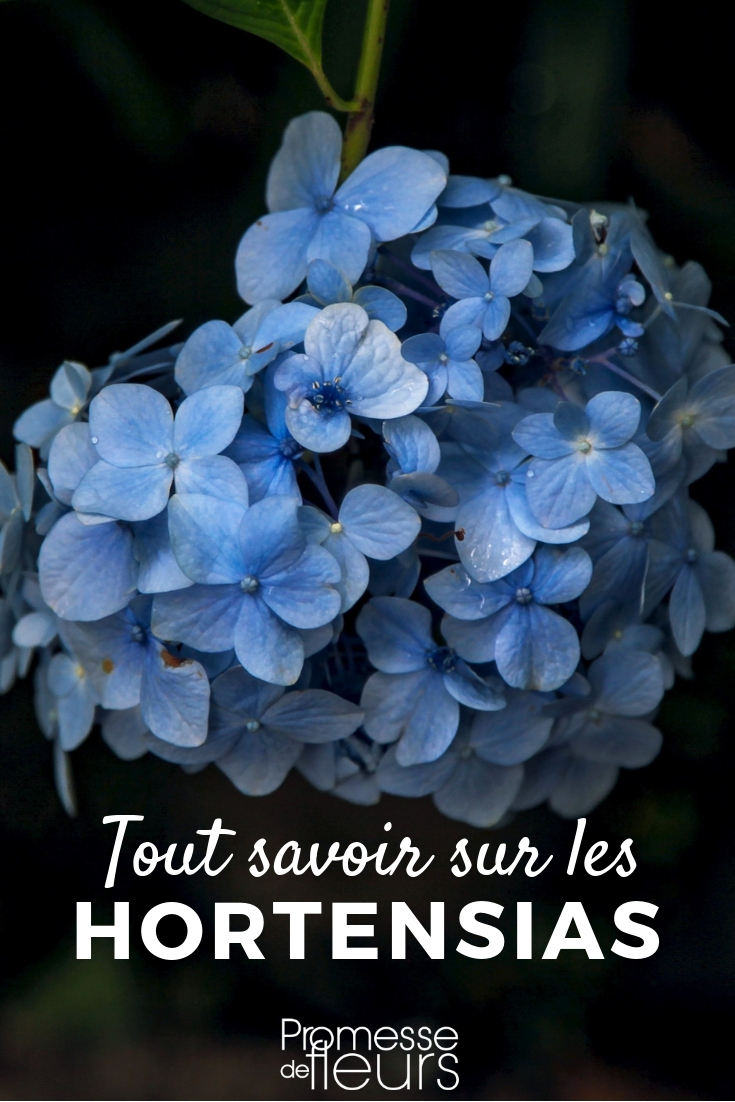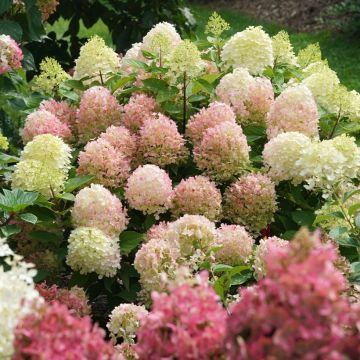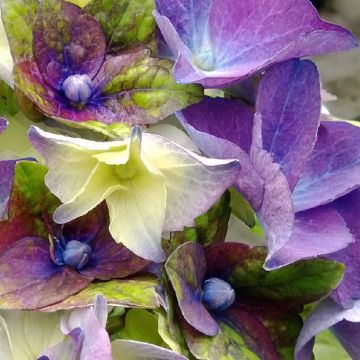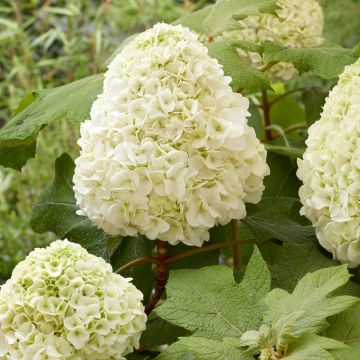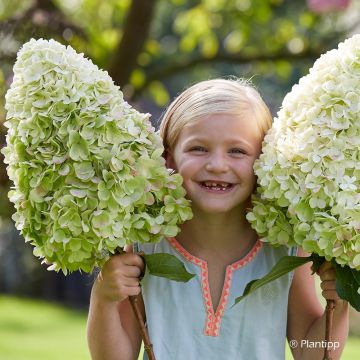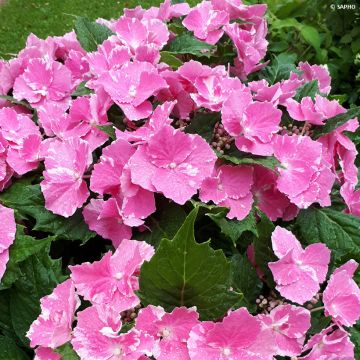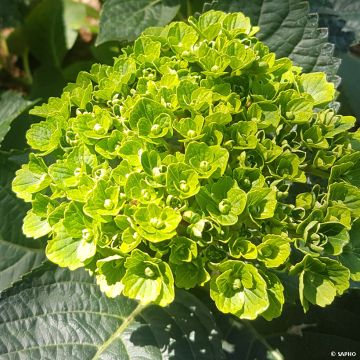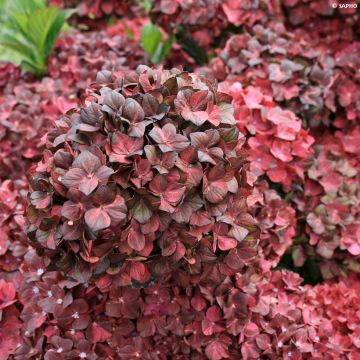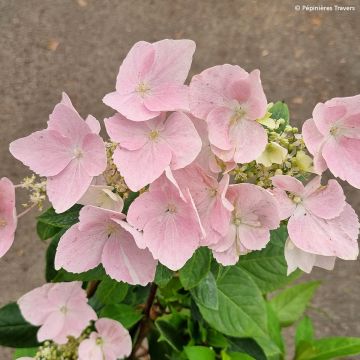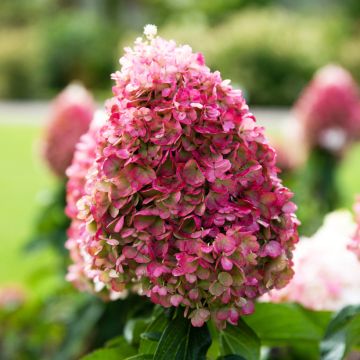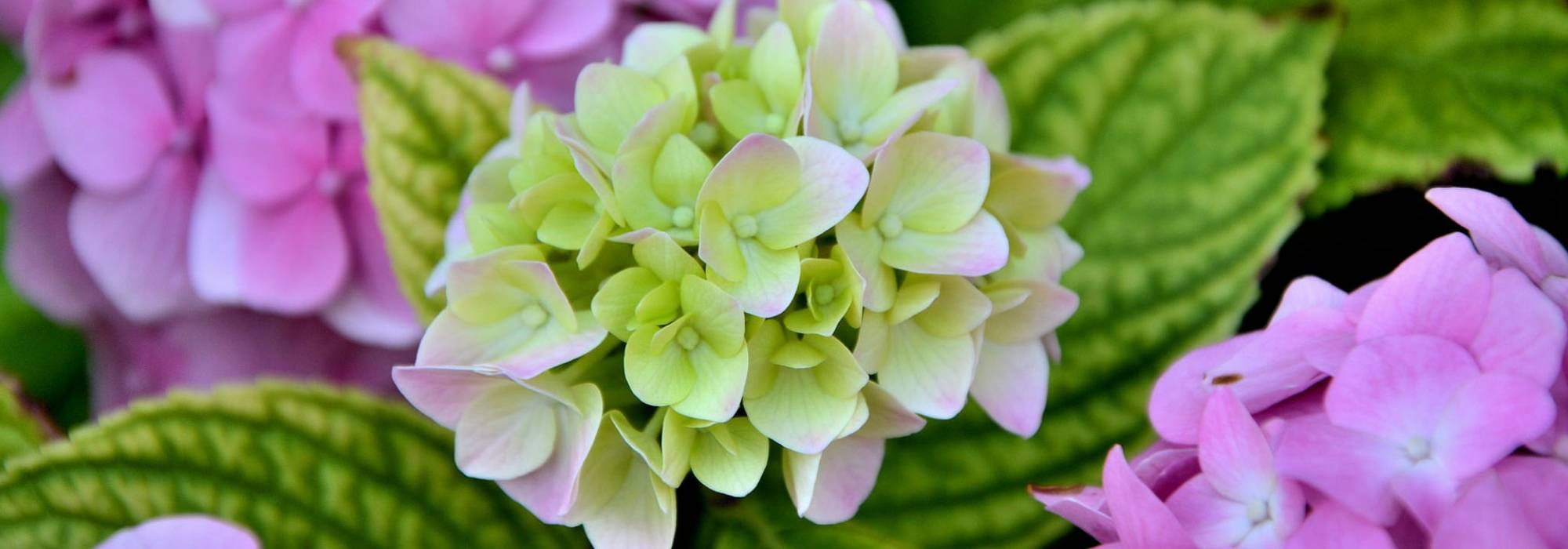
Hydrangeas: planting, pruning and care
Contents
Hydrangeas in a nutshell
- Hydrangeas offer long-lasting flowering, generally from June to September or October
- They produce large, spherical, flattened or conical inflorescences, often pink or blue
- Their foliage is decorative and can turn beautiful autumn colours
- Although most are shrubs, there are also climbing varieties
- They are plants that are easy to grow and maintain
- They are perfect for hedging or borders and can also be grown in pots
A Word from Our Expert
The hydrangeas are bushes (sometimes climbing plants) that offer impressive flowering, generally in large spherical inflorescences, which lasts throughout summer: from June to September. Flowering is usually blue or pink, but hydrangeas can also be white, mauve, red… Colours of some varieties have the peculiarity of changing depending on soil pH: the more acidic the substrate, the bluer the flowers; the more calcareous it is, the pinker they become.
Most familiar are the Hydrangea macrophylla, which produce large inflorescences often flat or globe-shaped. This is the case, for example, with the superb variety ‘Endless Summer The Bride’. These hydrangeas represent, however, only a small part of a vast and very diverse group. Hydrangea arborescens, such as variety ‘Annabelle’, Hydrangea paniculata (for example ‘Vanille Fraise’) and Hydrangea serrata also offer very beautiful flowering. Hydrangea quercifolia, for their part, are particularly interesting for their autumn foliage. There are also climbing hydrangeas.
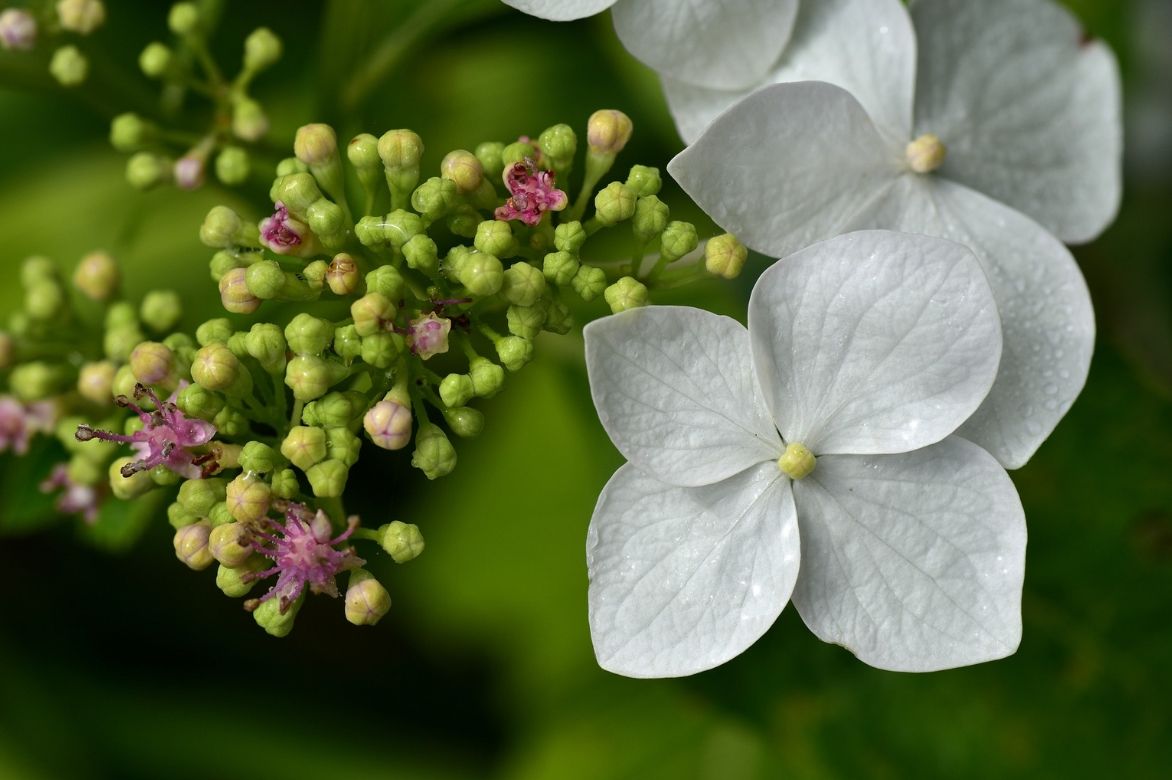
Established in good conditions, hydrangeas are easy to grow and maintain! Hydrangea macrophylla and serrata thrive in shaded positions and on rather acidic soil, while other species can quite happily tolerate sun or calcareous soils. You will easily find one suited to your situation! They can be placed at the back of a border, in woodland, in a hedge or as an edging. The more compact ones can be grown in pots or tubs and placed, for example, on a patio or in a courtyard! For maintenance, ensure substrate stays relatively cool and prune in late winter.
Description and botany
Botanical data
- Latin name Hydrangea sp.
- Family Hydrangeaceae
- Common name Hydrangea
- Flowering June to September–October
- Height often between 80 cm and 2 m
- Exposure preferably partial shade
- Soil type rich, humus-bearing, fresh, loose and well-aerated
- Hardiness generally between -15 and -25°C.
Hydrangeas, called in Latin Hydrangea, are mainly bushes and include around fifty species, plus very many varieties! What gardeners usually mean by hydrangea most often refers to Hydrangea macrophylla, the species most widely cultivated. There are in fact more than 600 horticultural varieties of Hydrangea macrophylla.
Hydrangeas originate mainly from East Asia, although a few species occur in North America (for example Hydrangea arborescens…). Many species come from China, Japan and Korea. Hydrangea macrophylla, for instance, is native to Japan, but has naturalised in several regions worldwide (Central America, New Zealand…).
Hydrangea gives its name to family Hydrangeaceae (237 species), which also includes other ornamental plants such as Deutzia and Philadelphus. Some genera are very close to hydrangeas: Pileostegia, Schizophragma… Schizophragma are sometimes considered climbing hydrangeas!
Hydrangeas form bushes with a fairly broad, rounded habit. Most reach between 80 cm and 2 m in height. Some Hydrangea paniculata grow particularly tall (variety ‘Levana’, for example, reaches 3 m). Climbing hydrangeas (Hydrangea petiolaris and H. seemanii) are an exception, as they can reach 10–15 m! If you wish to grow hydrangeas in a pot, choose more compact varieties such as Hydrangea paniculata ‘Bobo’, or Hydrangea serrata…
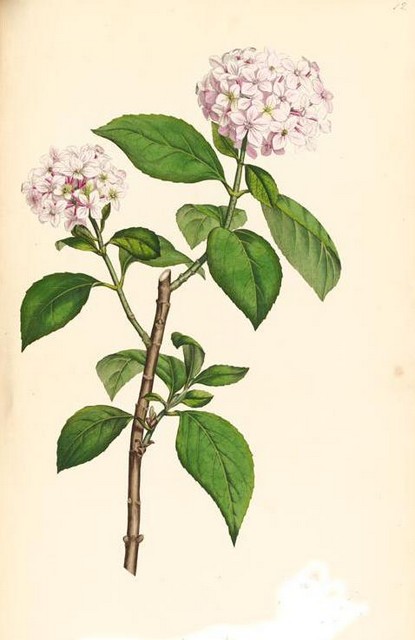
Hydrangea macrophylla – botanical illustration
Hydrangeas are long-lived. In good growing conditions they can live for several decades, sometimes 50 years.
Hydrangeas generally flower throughout summer, from June until September–October. Those of the ‘Endless Summer’ series were selected for their very long flowering period!
They then produce large inflorescences made up of many flowers. These can be globular; flat (with all flowers on same level); or conical (Hydrangea paniculata). They form corymbs or paniculate clusters, often at stem tips, and can measure up to 15–20 cm across. Hydrangea inflorescences resemble those of some Viburnum!
Hydrangea arborescens are also valued for large inflorescences often creamy in tone (white–pale yellow, soft pink, pastel…): variety ‘Annabelle’, for instance, bears large white spheres that bend stems under their weight. Variety ‘Hayes Stardust’ has inflorescences up to 20 cm across made of small star-shaped flowers in creamy white to light green shades.
Some hydrangeas have very unusual flowers! Hydrangea macrophylla ‘Camino’, for example, surprises with inflorescences of rounded flowers with dentate edges. In ‘Hovaria Hopcorn’, sepals are rounded, incurved. Conversely, they are very fine and star-shaped in Hydrangea macrophylla ‘Princess Diana’ and ‘Stargazer’. Flowers can also be double, when each floret bears many sepals.
Inflorescences generally carry two types of flowers: large sterile flowers, very decorative, around periphery, and small fertile flowers, more discreet, at centre. In sterile flowers it is the enlarged sepals that are decorative; they look like petals. Fertile flowers bear many stamens. Horticultural varieties have been selected for large numbers of decorative sterile flowers.
Some hydrangeas have particularly vivid, extravagant blooms. Other times flowers are more delicate and natural. They can be very romantic, as in Hydrangea ‘You And Me Romance’…
Hydrangea flower colours are very attractive, often pink or blue. Flowers can also be white, red, mauve–violet, green… Sometimes bicoloured, as in Hydrangea macrophylla ‘Mirai’. Some varieties are remarkable for colour combinations, such as ‘Schloss Wackerbarth’.
Colours also tend to change with time, flowers sometimes taking green or pink–red shades. Colour change is very marked in some varieties, such as Hydrangea paniculata ‘Vanille Fraise’ (flowers first white and pink, then turning red), or hydrangeas of the ‘Magical’ series.

Different inflorescence forms: round-headed / flat-headed / paniculate
With Hydrangea macrophylla and Hydrangea serrata, flower colour has the particularity of changing according to soil pH: flowers turn blue in acidic soil and more pink in calcareous soil. It is therefore possible to slightly alter colour (to obtain blue) by adding, for example, aluminium sulfate in the form of alum, or crushed slate. White-flowering varieties do not change colour with pH.
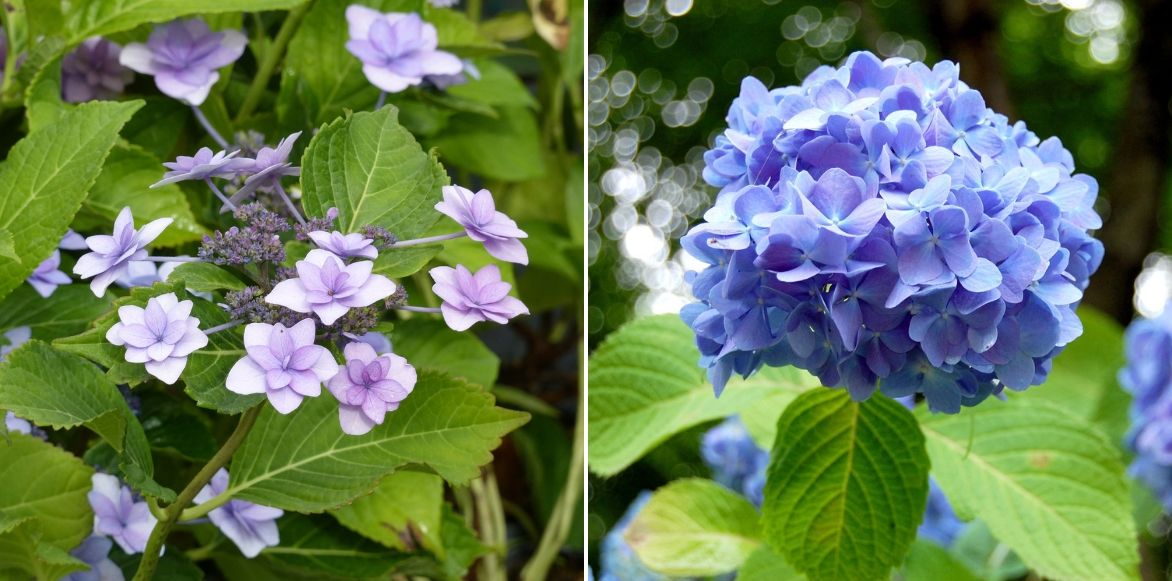
Hydrangeas with blue flowers in acidic soil
Hydrangea flower colours therefore show great variability, depending on pH but also on season (early or late flowering).
Feel free to harvest flowers and dry them for dried bouquets! You can consult our advice sheet on how to dry hydrangea flowers.
Hydrangeas bear large leaves, often broad and ovate, measuring between 10 and 25 cm long. Species name macrophylla indeed means “large-leaved”. Leaf lamina margin is dentate. In Hydrangea quercifolia, leaves are lobed and resemble oak foliage, which gave the species its name (Quercus = oak in Latin).
Leaves are generally opposite (placed two by two on stems). They can also be inserted in threes (whorled).
Most cultivated hydrangeas are deciduous, except Hydrangea seemanii.
Usually hydrangea leaves are dark green. Foliage can also be variegated, as in Hydrangea petiolaris ‘Silver Lining’, with margins of white. Leaves are purple in Hydrangea macrophylla ‘Julisa’. As with flowers, hydrangea leaves can change colour at year end, taking fine autumn hues, especially in Hydrangea quercifolia! Variety ‘Snowflake’, for example, has leaves that turn purple late in season. Colour-wise, the most striking is perhaps hydrangea ‘Little Honey’, which bears superb golden-yellow foliage dazzling through season, then colouring orange–red in autumn!

Various foliage: Hydrangea macrophylla, Hydrangea quercifolia ‘Little Honey’, Hydrangea paniculata, Hydrangea petiolaris ‘Silver Lining’, Hydrangea macrophylla ‘Merveille Sanguine’
Stems are black in Hydrangea macrophylla ‘Nigra’ and ‘Zorro’, which highlights green foliage and flower colour.
Some hydrangeas are also villous, with more or less downy stems and leaves. This is the case in Hydrangea aspera, Hydrangea villosa and Hydrangea involucrata.
After pollination, flowers form capsules that open when ripe. These contain tiny seeds.
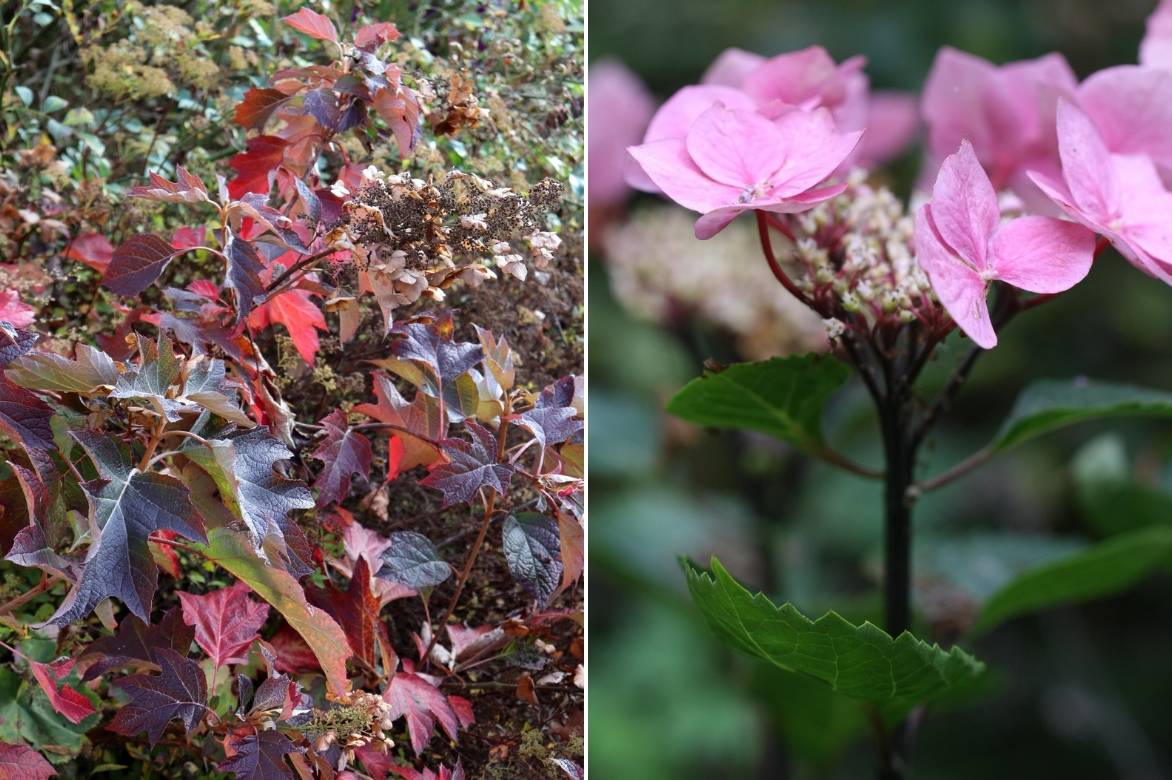
Beautiful autumn colours of Hydrangea quercifolia ‘Burgundy’ / Dark stems of Hydrangea macrophylla ‘Zorro’
Although hydrangeas are generally fairly hardy, some Hydrangea macrophylla varieties can be somewhat tender. The most cold-sensitive include varieties Hydrangea macrophylla ‘Mirai’ (-12°C) or ‘Leuchtfeuer’. Conversely, more resistant varieties include ‘Blueberry Cheesecake’, ‘Magical Noblesse’, ‘Ayesha’, and those of the ‘Endless Summer’ series. Among other hydrangea groups, Hydrangea serrata are particularly hardy. If you live in a cold-climate region and grow Hydrangea macrophylla, we recommend planting them near a west-facing wall. This will help them persist and flower well.
Read also
Hydrangeas: how to choose them?Main hydrangea varieties
These are Hydrangea macrophylla and Hydrangea serrata. They have a fairly ‘classic’ growing habit for hydrangeas: they like to be sheltered from direct sun and do well in soils with an acidic tendency. Hydrangea macrophylla are the most common hydrangeas, with large spherical inflorescences. H. serrata are smaller, offer delicate flowering, often flattened or domed, and are very hardy.
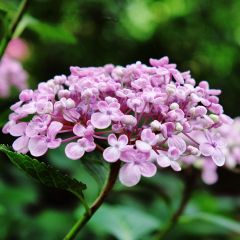
Hydrangea macrophylla Ayesha
- Flowering time August to October
- Height at maturity 1,50 m
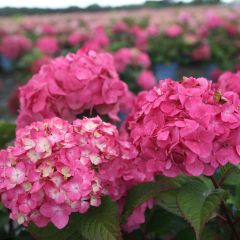
Hydrangea macrophylla Endless Summer Bloomstar
- Flowering time July to November
- Height at maturity 1,70 m
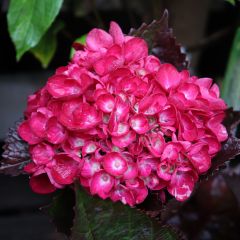
Hydrangea macrophylla Merveille Sanguine
- Flowering time September to November
- Height at maturity 2 m

Hydrangea serrata Blue Bird - Mountain Hydrangea
- Flowering time August to October
- Height at maturity 1,20 m
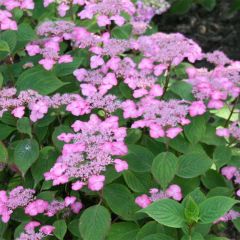
Hydrangea serrata Avelroz - Mountain Hydrangea
- Flowering time July, August
- Height at maturity 1 m
These are mainly Hydrangea paniculata. These hydrangeas produce large conical inflorescences, in panicles. They need sufficient light to flower well! Hydrangea arborescens and quercifolia can also grow in sun.
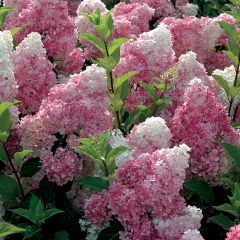
Hydrangea paniculata Vanille Fraise
- Flowering time August to November
- Height at maturity 2,50 m
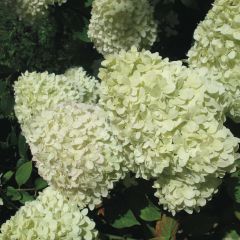
Hydrangea paniculata Limelight
- Flowering time August to November
- Height at maturity 2 m
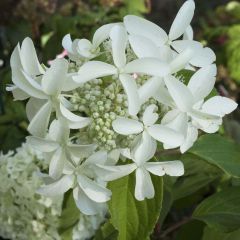
Hydrangea paniculata Great Star Le Vasterival
- Flowering time August to November
- Height at maturity 2 m
Indeed, although Hydrangea macrophylla prefer acidic soils and dislike lime, this is far from true for all hydrangeas! In fact, Hydrangea arborescens and quercifolia will accept calcareous substrates. Hydrangea arborescens forms a shrub bearing large rounded inflorescences. Hydrangea quercifolia, for its part, is prized for its lobed foliage and lovely autumn colours.
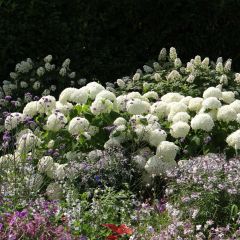
Hydrangea arborescens Annabelle
- Flowering time July to October
- Height at maturity 1,50 m
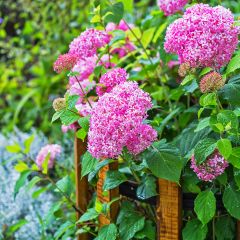
Hydrangea arborescens Pink Annabelle - Invicibelle
- Flowering time July to November
- Height at maturity 1,50 m
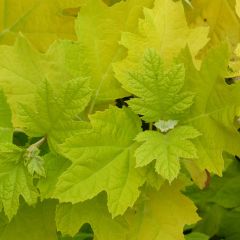
Hydrangea quercifolia Little Honey
- Flowering time September to November
- Height at maturity 1,50 m
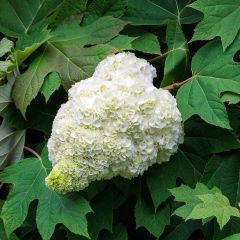
Hydrangea quercifolia Harmony
- Flowering time August to November
- Height at maturity 2,50 m
These are the petiolaris and seemanii hydrangeas. They offer white, fairly light and airy inflorescences, and have the advantage of being able to flower even in shade! You can plant them, for example, against a north-facing wall. They attach themselves using their climbing roots, and can climb very high!
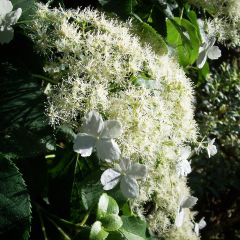
Hydrangea anomala subsp. petiolaris- Climbing Hydrangea
- Flowering time July, August
- Height at maturity 4 m

Hydrangea petiolaris Silver Lining- Climbing Hydrangea
- Flowering time June, July
- Height at maturity 3,50 m
These are the most compact hydrangeas, reaching at most one metre in height.
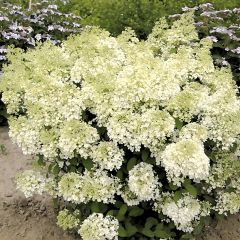
Hydrangea paniculata Bobo
- Flowering time September to November
- Height at maturity 70 cm
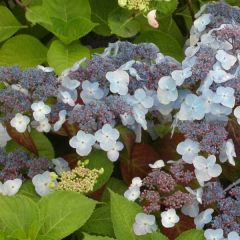
Hydrangea serrata Shôjo - Mountain Hydrangea
- Flowering time July to September
- Height at maturity 1 m
If you still have difficulty deciding among all these varieties, do not hesitate to consult our factsheet Hydrangeas – How to choose them?
Discover other Hydrangeas
View all →Available in 1 sizes
Available in 1 sizes
Available in 1 sizes
Available in 1 sizes
Available in 1 sizes
Available in 2 sizes
Available in 2 sizes
Available in 2 sizes
Available in 1 sizes
Available in 2 sizes
Planting hydrangeas
Where to plant?
Most hydrangeas, notably Hydrangea macrophylla and serrata, prefer semi-shade, sheltered from sun during hottest hours of afternoon! Climbing hydrangeas are perfect for planting on a north-facing wall. Also avoid sun for hydrangea ‘Little Honey’: its golden foliage could scorch. Hydrangea paniculata and arborescens, on the other hand, enjoy sun!
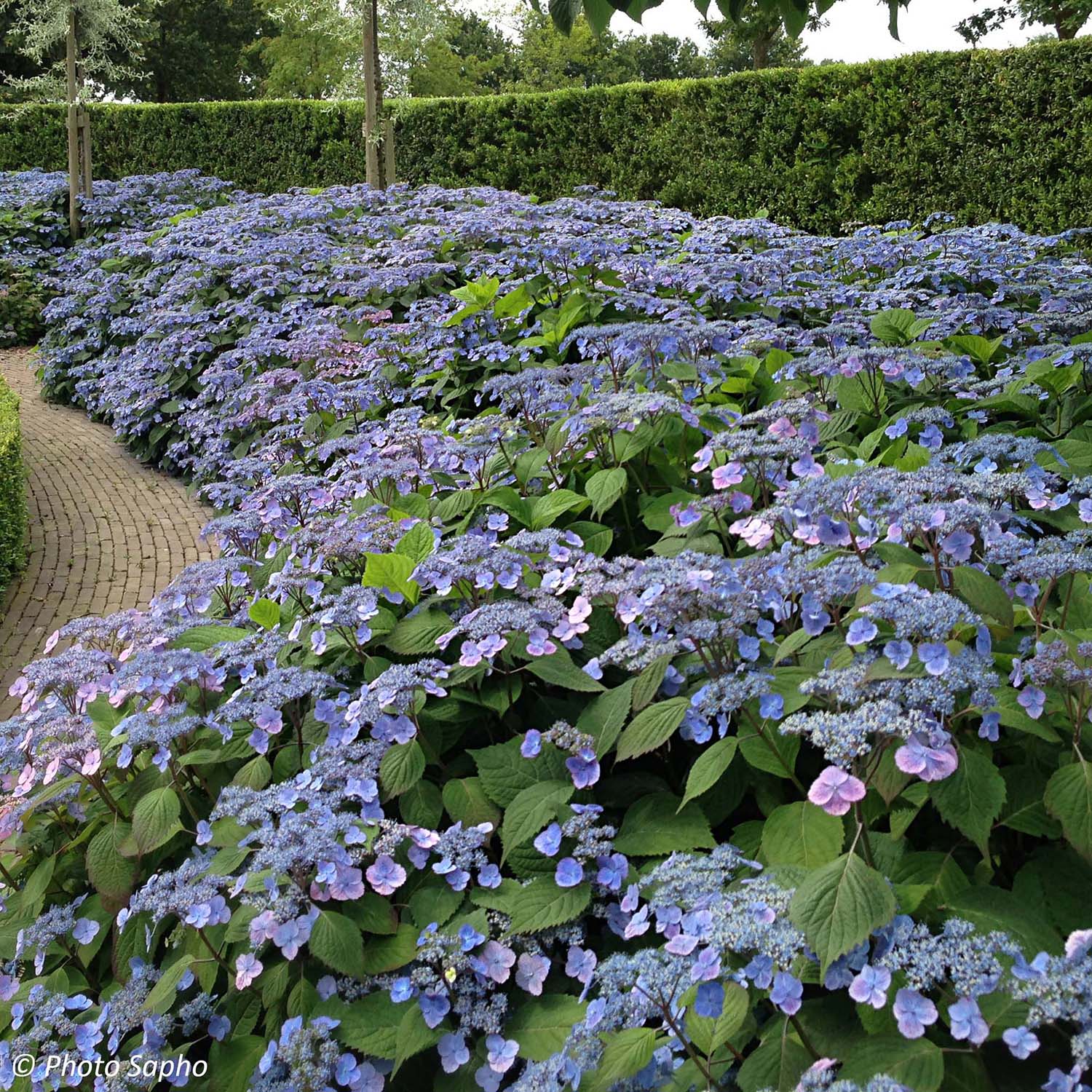
Hydrangea serrata ‘Veerle’
Plant hydrangeas in soil that stays cool in summer. Most species dislike drought. Hydrangeas appreciate soils rich in organic matter, fertile. They like light, well-aerated soil. They will thrive in soil similar to woodland topsoil, found naturally in forests. They will do less well if planted in compact soil.
As a rule, hydrangeas do not like markedly calcareous soil, which causes chlorosis (yellowing of leaves). They prefer slightly acidic or neutral soils. If your soil is calcareous, you can grow them in pots, or dig a wide planting hole and fill it with potting compost, which you can mix with a little heather soil. However, Hydrangea paniculata, arborescens, quercifolia and sargentiana tolerate limestone well (read our advice sheet on this subject Hydrangeas on calcareous soil, it’s possible!).
It is preferable to place hydrangeas in a spot sheltered from wind. Choose a slightly sheltered position (for example, against a wall). The plant will then be less vulnerable to late spring frosts.
You can place hydrangea at back of a border, in a hedge, at an edge… Planting in a pot is also a good solution to adorn a patio or courtyard. In that case choose Hydrangea paniculata ‘Bobo’, or Hydrangea serrata, which have a rather compact habit. Climbing varieties are perfect for dressing a north-facing wall.
When to plant?
Hydrangeas are preferably planted in early autumn, around September, but planting can also be done in spring, after last frosts.
Hardier species can also be planted in winter or summer, provided periods of frost or hot spells are avoided.
How to plant?
Keep at least one metre between two hydrangeas, although this also depends on variety chosen.
- Place rootball in a basin filled with water. This allows proper rehydration and makes subsequent watering easier.
- Meanwhile, dig a planting hole. It should be about three times the size of the rootball.
- Add organic matter: well-rotted compost or manure, organic fertiliser (crushed horn, dried blood…). If you grow Hydrangea macrophylla, you can also add a little heather soil (especially if you want blue flowers, or if your soil is calcareous).
- Remove plant from its pot.
- Rake bottom of the rootball to loosen the roots slightly.
- Place plant in the planting hole, collar level with soil surface, then firm down lightly.
- Water generously.
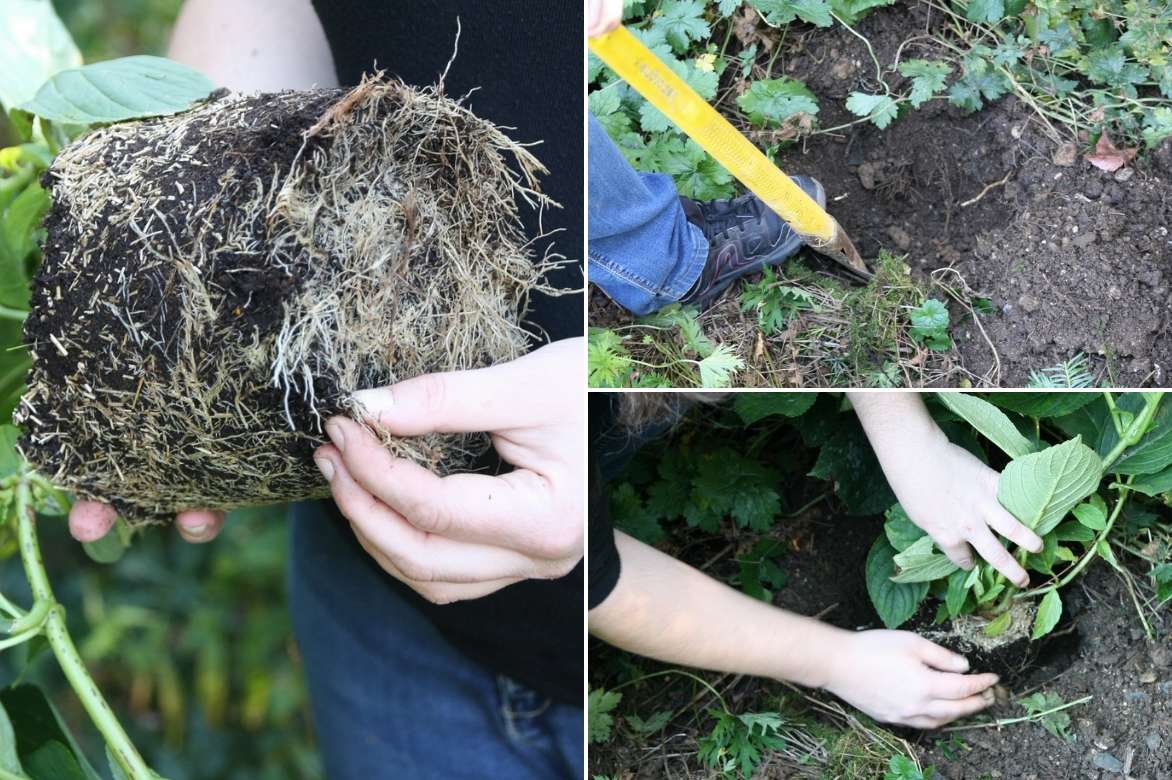
Planting a hydrangea
As hydrangeas appreciate soil that stays cool, it is always best to apply a layer of organic mulch at their base: choose, for example, BRF, fallen leaves, pine bark… Also, water regularly for several weeks after planting.
Hydrangeas can very well be grown in pots and tubs; for all details, consult our advice sheet: “Hydrangea in a pot: planting and care”
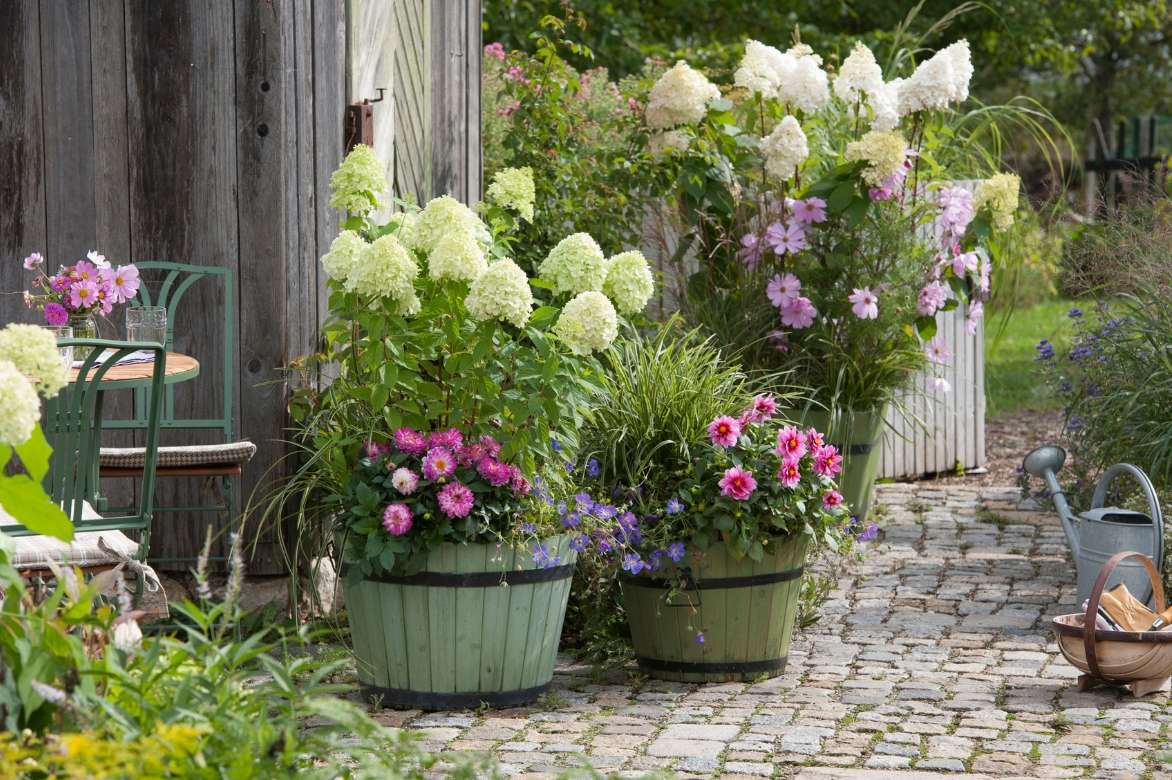
Hydrangea paniculata ‘Vanille Fraise’ grown in large barrels ( ©Biosphoto – Friedrich Strauss)
Caring for hydrangeas
Hydrangeas need soil to remain relatively cool. Water during summer, especially in dry spells. Be vigilant, particularly in first year or when growing in a pot (potting mix dries out more quickly). Avoid using hard water; prefer rainwater. Also beware of excess moisture: hydrangeas do not like standing water, which may encourage disease.
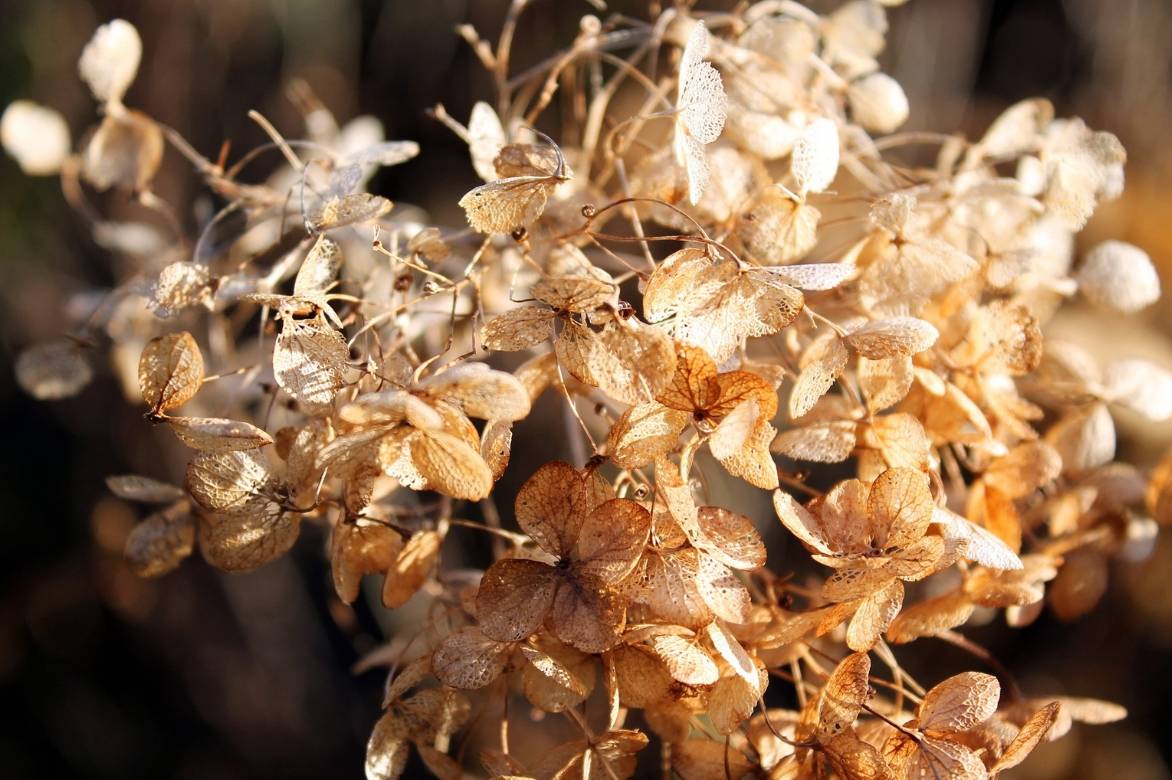
Inflorescence of a withered hydrangea
We recommend applying some well-rotted compost at the base of your hydrangeas in spring, to enrich soil. Incorporate it into soil by lightly scratching surface with a hand fork. You can also add horn meal or blood meal. However avoid excess fertiliser or organic matter, as this can encourage plant to produce lots of foliage at expense of flowering.
Similarly, it is preferable to always keep a layer of mulch at the base of the bush, as this helps soil remain cool while limiting weed growth… And as it decomposes, this mulch will enrich soil. Use for example ramial chipped wood or dead leaves, to a depth of at least 5 cm.
If you grow your hydrangea in a pot, remember to repot from time to time. You can do this every two years, at beginning of spring.
When inflorescences are withered, it is best to leave them in place over winter, as they will protect stems from cold. Cut them only at start of spring.
To keep blue flowers on your hydrangeas, you can occasionally add alum or crushed slate. We explain more in our article : How to get a blue hydrangea in the garden?
How to prune hydrangeas?
Pruning encourages generous flowering and helps plant maintain a balanced, harmonious shape. You can prune hydrangea each year in March–April. Carry out very light pruning on Hydrangea macrophylla and H. serrata, removing mainly dead wood, damaged branches and withered inflorescences. If you prune too short you may compromise flowering, because flower buds form at tips of stems. You can also thin and aerate centre of bush by removing some branches. Prune more severely Hydrangea paniculata and arborescens: cut back previous year’s branches, cutting just above healthy buds. We also recommend fairly light pruning for climbing hydrangeas. When pruning, always prioritise removal of damaged, malformed or dead branches.
For full details on pruning hydrangeas, see our advice sheets : When to prune hydrangeas? and How to prune hydrangeas?
Also see Tips to protect hydrangeas in winter
Hydrangea diseases and parasitic problems
Hydrangeas can be affected by several diseases. Take particular care with Botrytis cinerea, a fungal disease also known as grey mould and favoured by heat and humidity. They can also be affected by powdery mildew, which appears as a white, felt-like coating on leaves. For both these fungal diseases, treat using a sulphur-based solution.
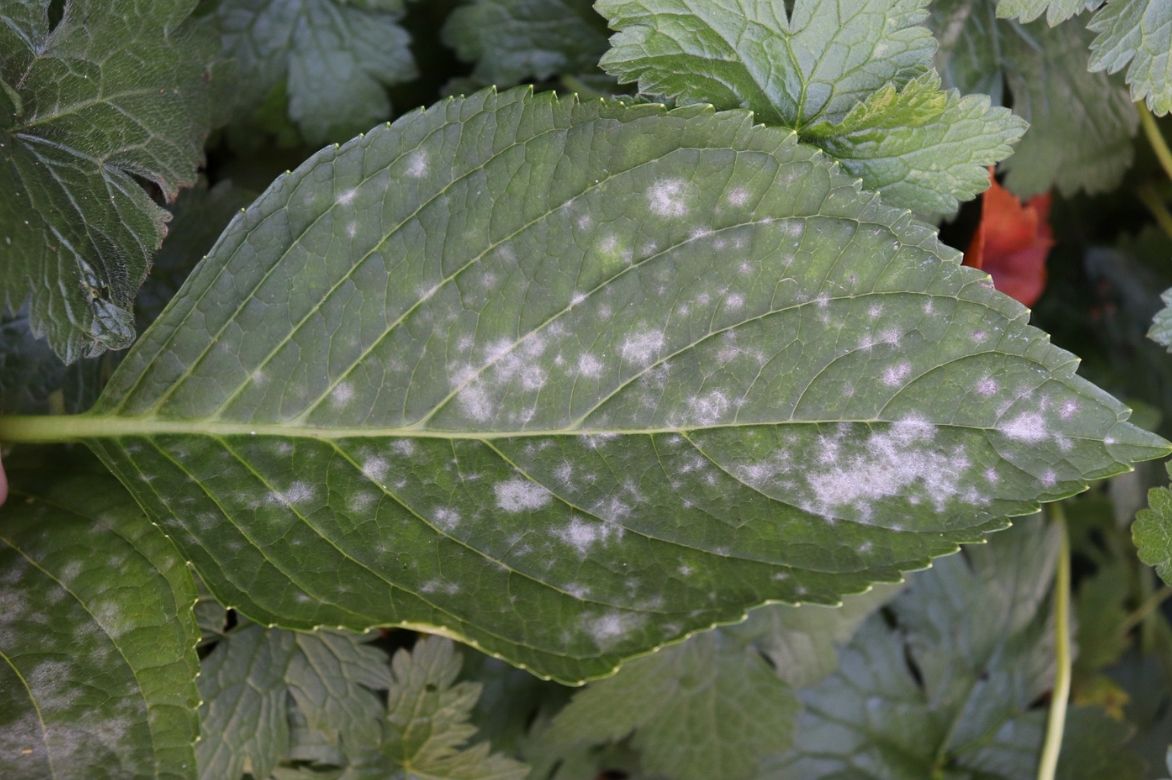
Hydrangea leaf affected by powdery mildew
Regarding pests, hydrangeas are particularly susceptible to attacks by cottony cushion scale (Pulvinaria hydrangeae). These are small elongated insects with a white, cottony appearance. If not too numerous, you can remove them with a cloth soaked in soapy water. Aphids also sometimes attack hydrangeas. They pierce leaves and feed on sap, which weakens the plant. To get rid of them, use black soap. You may also encounter problems with red spider mites. As these dislike humidity, simply spray water onto foliage.
If substrate is too calcareous, hydrangea may suffer from chlorosis. Foliage discolours, becoming yellow between veins. Plant is deficient: calcium present in soil blocks plant’s iron uptake. Use iron chelate (readily absorbed), or consider growing the plant in a pot, in a mix of potting compost and heather soil.
Propagation
Best technique to multiply hydrangeas is propagation by cuttings. It is also possible to sow seeds in late winter, but this method is slower and more difficult. Climbing species are usually propagated by layering.
Propagation by cuttings
Hydrangeas multiply very well by propagation by cuttings! This technique is fairly easy. Prefer to do it in late summer, around August, on semi-woody stems.
- Choose a healthy young stem (that grew during the year), not flowering, and cut it using pruning shear, just below a node (leaf insertion point). It should measure about 15 cm in length and carry at least three pairs of leaves.
- Remove leaves from the base, leaving only two or three leaves. If those at the top of the cutting are large, trim them in half.
- Prepare a pot with potting compost, then water to moisten it.
- Optionally dip the base of the stem in plant hormone.
- Make a small hole in the substrate using a small cane or a pencil.
- Plant the cutting, and firm the substrate around it to remove air pockets.
- You can cover the pot with a plastic bag to retain high humidity (enclosed propagation).
- Then place in a sheltered warm spot, without direct sunlight.
Keep substrate slightly moist until cutting starts growth.
→ Learn more about hydrangea cutting in our tutorial!
… as well as our advice sheet: Getting good cuttings from climbing hydrangea Hydrangea petiolaris
Pairing hydrangeas in the garden
Since Hydrangea macrophylla and Hydrangea serrata are rather suited to shady spots, they will easily find a place in a woodland garden. Plant them, for example, with foxgloves, Paris polyphylla, hostas, Geranium nodosum, ferns and Thalictrums. Also consider Brunnera macrophylla, which offer superb foliage and very delicate, charming flowering. Create a shady, cool corner with a fairly natural style. Although at first glance the large inflorescences of hydrangeas can seem “artificial” and exuberant, some varieties have more delicate flowerings and can perfectly fit into a fairly natural, wild-looking border.
In sun, you can use Hydrangea paniculata to compose a colourful border, with perennials and long-flowering bushes. Place hydrangeas towards the back, and put nepetas, Verbena bonariensis, echinaceas, Achillea, hardy geraniums in front. This will give you a flowering border throughout summer. Feel free to scatter some ornamental grasses (Stipa, Pennisetum, Briza media …) to add lightness and movement.
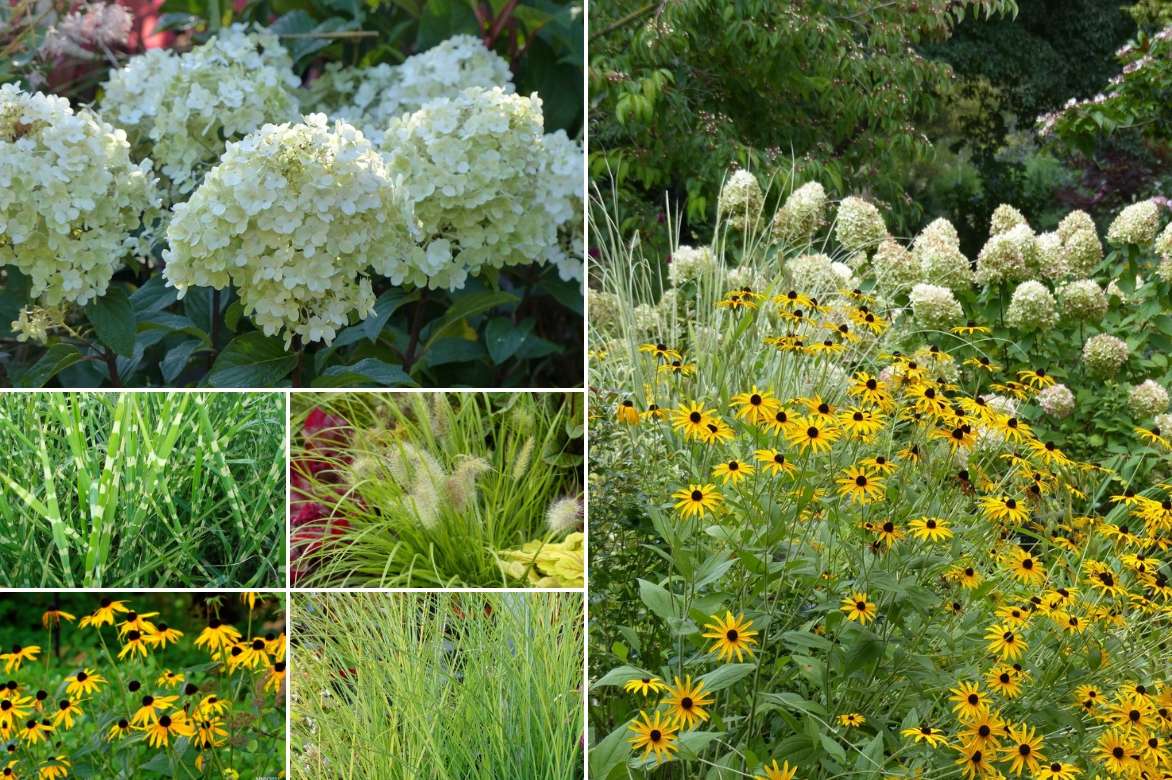
An idea for a sunny combination: Rudbeckia fulgida ‘GoldSturm’, Miscanthus sinensis ‘Zebrinus’ and ‘Gracillimus’, Pennisetum alopecuroides ‘Hameln Gold’, Hydrangea paniculata ‘Limelight’
As Hydrangea macrophylla prefer rather acidic soils and shady spots, you can plant them with other species that will enjoy the same conditions, such as azaleas, camellias, Pieris or skimmia. Add a few ferns if desired.
Hydrangeas can be incorporated into a romantic garden. Pair them with other plants with delicate flowerings, such as astrantias, gypsophilas or foxgloves. For hydrangeas, you might choose a variety such as ‘You and Me Romance’, which offers a very romantic flowering. Varieties with white flowers also suit this style of garden.
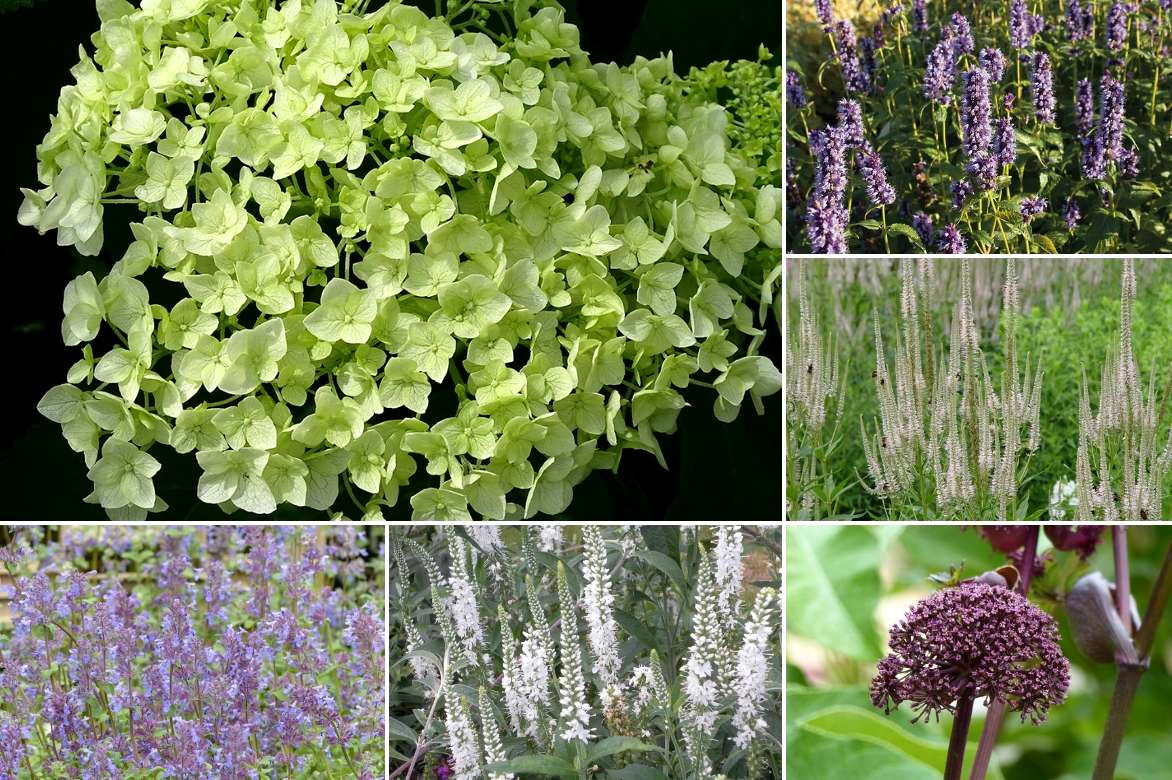
An example of a romantic combination: Hydrangea arborescens ‘Annabelle’, Agastache ‘Black Adder’, Veronicastrum virginicum var abum, Angelica gigas, Veronica spicata ‘Alba’, Nepeta faassenii ‘Six Hills Giant’
Because they offer lush foliage and delicate, generous flowering, often in blue or white tones, hydrangeas are perfect for a cottage garden! Plant them with delphiniums, oriental poppies, cosmos, hardy geraniums… The aim is a border that is both wild and abundant, with a profusion of flowers opening in soft, pastel tones.
Finally, you can pair Hydrangea quercifolia with other plants that take on beautiful autumn colours: maples, dogwoods, Nandina domestica…
Useful resources
Discover:
- our (very) wide range of hydrangeas
- Our blog articles: Top 5 late-season hydrangeas, How to ruin your hydrangeas in 10 lessons, Hydrangea arborescens, standing up to heat!, Hydrangea involucrata Yoraku Tama, a Japanese hydrangea to discover, Exceptional, graphic flowers for Hydrangea paniculata ‘Skyfall’, 7 good reasons to plant Hydrangea quercifolia, Hydrangea arborescens ‘BellaRagazza’: world’s first compact ‘Annabelle’ hydrangeas!; I visited Madeira, island of flowers
- Our advice sheets: Hydrangeas: how to choose them?, How to grow your hydrangeas successfully, Get beautiful cuttings from your Hydrangea petiolaris, Drying hydrangea flowers, 10 summer-flowering bushes every garden should have!, 6 sun-loving, drought-resistant hydrangeas, Hydrangeas in autumn colours, Protect your hydrangeas from heatwave ; 7 compact hydrangeas that stay beautiful for long; 7 double-flowered hydrangeas; Red hydrangea: best varieties ; Choosing a hydrangea by frost tolerance; 6 hydrangeas with coloured wood or foliage; 5 hydrangeas with evolving flowers ; Climbing hydrangeas: our top 7 ; How to choose a bush hydrangea? ; Which hydrangeas for shade? ; 7 magnificent hydrangea varieties with flat flowers ; Evergreen and semi-evergreen hydrangeas.
- Don’t hesitate to visit the garden Shamrock and its superb collection of hydrangeas!
- Discover Sophie’s advice sheet featuring other bushes with extraordinary flowers!
- Hydrangea, a travelling plant: learn more with Gwenaëlle on our blog
- Alexandra explains how to save a hydrangea after heat stress and why my hydrangea doesn’t flower?
Frequently asked questions
-
Why are my hydrangea leaves turning yellow?
If the lamina is yellow between the veins, your hydrangea is suffering from chlorosis. This is caused by soil or water that is too calcareous. Excess lime prevents the plant from assimilating iron. If your soil is calcareous, consider growing hydrangeas in pots or containers. You can also dig a large planting hole and fill it with potting compost mixed with heather soil. Another solution is to apply iron chelate. We also recommend watering with rainwater rather than mains water.
-
Several common reasons explain why a hydrangea (hortensia) fails to flower, and each has a different remedy. Check the list below to diagnose and fix the problem.Main causes and solutions- Wrong pruning timing or method - Hydrangea macrophylla (mophead and lacecap) form flower buds on last year’s wood. Heavy pruning in late winter or early spring removes these buds. Remedy: avoid hard pruning in spring; deadhead spent blooms after flowering and prune lightly if needed. - Hydrangea paniculata and H. arborescens usually flower on new wood, so they can be cut back in late winter without losing next season’s flowers.- Winter frost or late cold damage - Buds that look brown or mushy in spring have often been killed by frost. Remedy: protect vulnerable plants in autumn/winter (mulch root area, cover if severe), and delay pruning until you can check for live wood.- Lack of light - Too much shade reduces flower initiation. Remedy: move plant (if in pot) or prune surrounding trees/shrubs to increase light. Ideally hydrangeas get morning sun and afternoon shade in hotter regions.- Excess nitrogen / too-rich feed - High nitrogen encourages leafy growth at expense of flowers. Remedy: stop high-nitrogen feeds (e.g. fresh manure or high-nitrogen fertilisers). Use a balanced fertiliser or one formulated for flowering shrubs, lower in nitrogen and with sufficient potassium/phosphorus.- Soil and root problems - Pot-bound plants or poorly drained/compacted soil stress the plant and reduce flowering. Remedy: re-pot into larger container with free-draining compost or improve soil drainage and loosen root zone. Avoid waterlogging.- Plant too young - Newly planted hydrangeas sometimes need 1–3 seasons to establish before producing abundant flowers. Remedy: be patient, care for plant and it should mature into flowering.- Variety-specific behaviour - Some cultivars naturally produce fewer or smaller flowers. Check cultivar’s flowering habit and expectations.Quick diagnostic checklist- Did you prune in late winter/early spring? (If yes and plant is H. macrophylla, that’s likely cause.)- Do buds appear healthy in early spring or are they brown/damaged?- Has plant been receiving lots of high‑nitrogen feed or fresh manure?- Is plant in deep shade or very exposed sunny position?- Is it pot-bound or showing root stress?- How old is plant and which cultivar is it?Immediate actions to try- Stop high‑nitrogen feed; apply a low‑nitrogen, bloom‑encouraging fertiliser in spring. - If frost-damaged, wait until late spring to assess live wood before pruning. - Move container plant to brighter spot or thin canopy nearby. - Re-pot if roots are circling or very crowded. - Mulch to protect roots and conserve moisture, but avoid burying crown.If you want, tell me: which hydrangea species or cultivar you have, where it’s planted (pot or garden), what pruning and feeding you do and your climate. With those details I can give tailored advice.
Check that the location suits it: Hydrangea paniculata or Hydrangea arborescens, for example, need sun (unlike most hydrangeas)! Likewise, avoid heavy shade for Hydrangea macrophylla and Hydrangea serrata – choose bright positions with light shade. You can also add some compost or manure to enrich the soil, but avoid fertilisers that are too rich in nitrogen: they encourage the plant to produce foliage at the expense of flowers! For Hydrangea macrophylla, flowering can be compromised by severe pruning. Bear in mind that climbing hydrangeas generally take several years to start flowering.
-
How can I make my hydrangea flowers blue?
Hydrangea flowers can turn blue in acidic soil in the presence of aluminium ions (Al3+). You can use an alum-based bluing agent or crushed slate. But if your soil is not acidic, this will probably not be enough. In that case, add some heather soil or grow hydrangea in a container.
However, note that not all varieties have the same ability to turn blue. Hydrangea macrophylla are the most likely to change colour, but white-flowered varieties will remain white.
-
My hydrangea's leaves have a white, felt-like covering.
Your plant is affected by powdery mildew, a disease caused by a fungus. We recommend cutting off affected parts, then spraying with a sulphur-based solution or a horsetail decoction.
-
Leaves bear small elongated white cottony tufts.
These are pulvinaria scale insects. They weaken hydrangea, potentially causing foliage to dry out and may cause sooty mould to develop. They multiply rapidly and can become proliferous in a short time. To get rid of them, use a cloth soaked in soapy water.
-
It's spring and my Hydrangea paniculata seems dead...
Hydrangea paniculata plants are slow to come into leaf in spring. If yours shows no sign of growth and still has no leaves by May, be patient — wait a little longer!
- Subscribe!
- Contents
